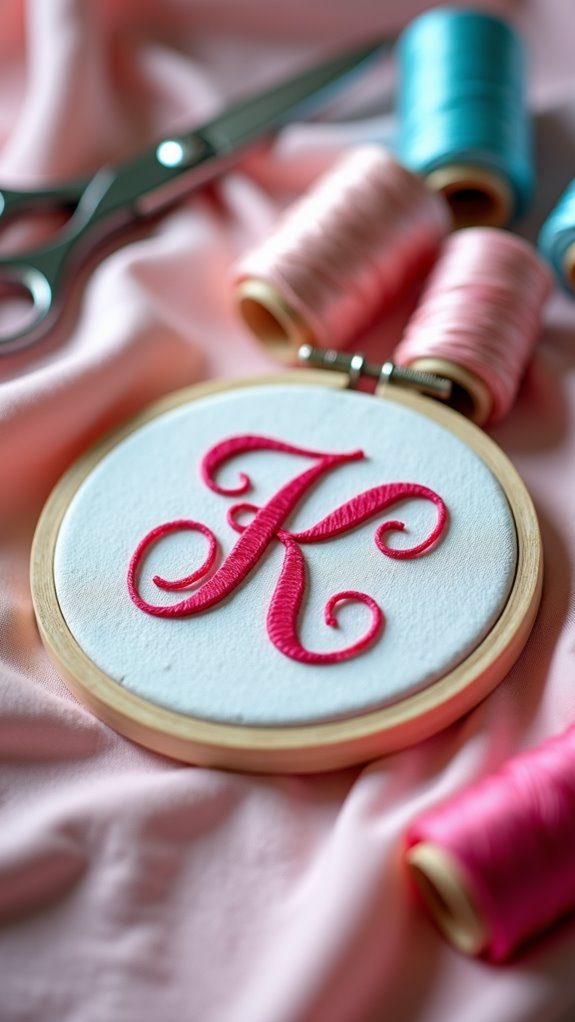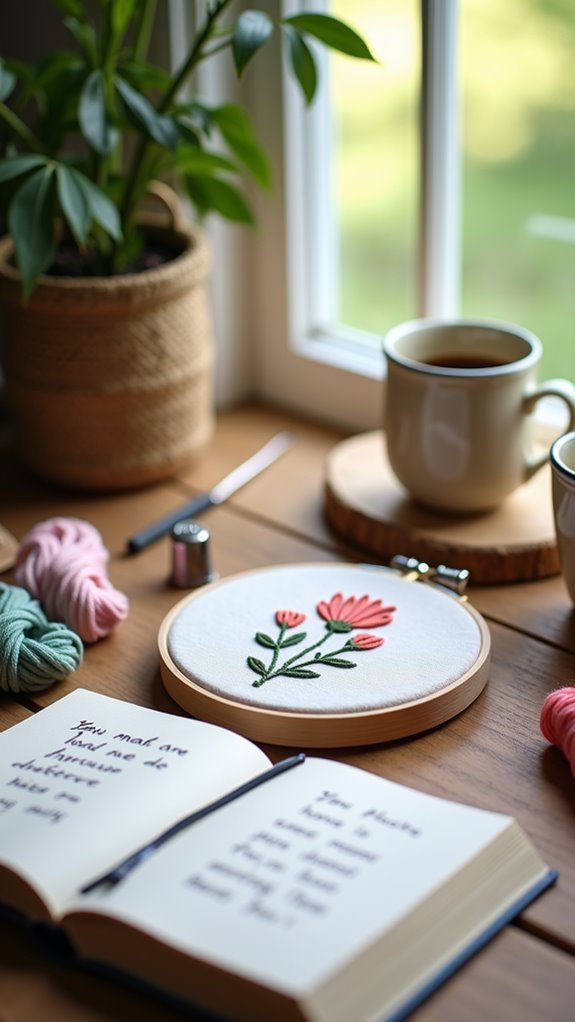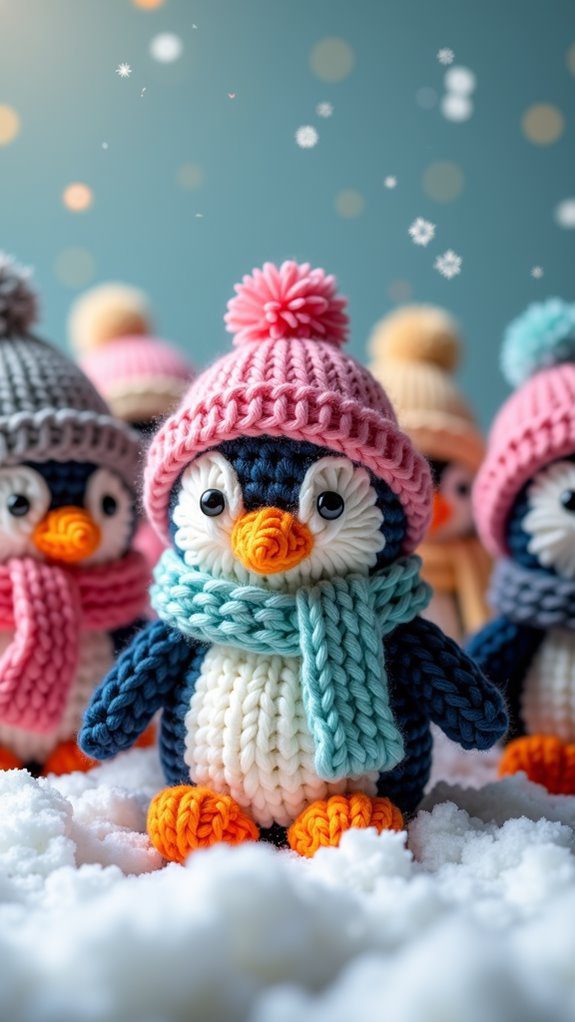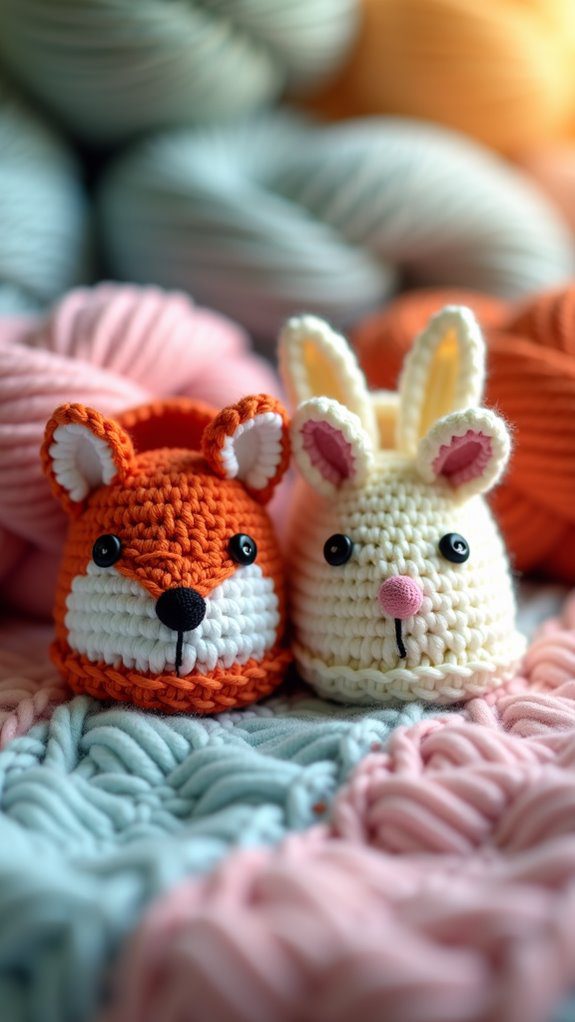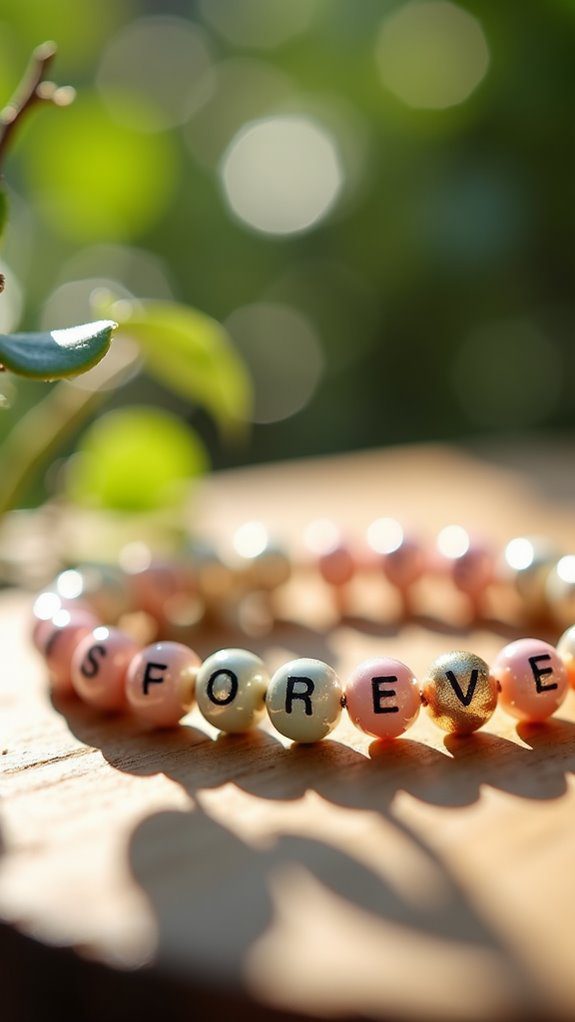If you’re looking for creative batik ideas, try traditional indigo with its rich blue hues and cultural stories, or modern geometric patterns featuring sharp lines and bold colors for a fresh vibe. Floral motifs bring natural beauty and symbolism, while abstract wax resist allows playful texture like crackle effects. Don’t forget tie-dye methods for unique blends and striped patterns that add rhythm. Each design carries meaning and artistry, and exploring these styles will inspire even more creative possibilities.
Key Takeaways
- Traditional indigo batik uses wax resist and plant dyes to create intricate patterns symbolizing protection and cultural heritage.
- Modern batik incorporates geometric shapes and vibrant colors for a fresh, trendy look blending tradition with innovation.
- Floral motifs in batik represent purity, love, and growth, often using symmetrical designs inspired by nature and philosophy.
- Nature-inspired batik includes mandalas, animal prints, and ocean waves, connecting patterns to harmony and cultural roots.
- Specific designs like stripes and tribal prints express rhythm, unity, and energy, reflecting stories of nature and tradition.
Traditional Indigo Batik Design
Although you might not realize it at first glance, traditional indigo batik design carries centuries of history and meaning woven into every deep blue pattern. The cultural significance runs deep—each pattern is more than decoration; it’s a story, a symbol of protection and wisdom. The dye extraction process itself is fascinating, using leaves from the indigo plant to create that rich blue color. Wax is applied to fabric, preventing dye in certain spots, so intricate designs emerge. When you wear or create indigo batik, you’re connecting with a heritage that’s both ancient and alive.
Modern Geometric Batik Pattern
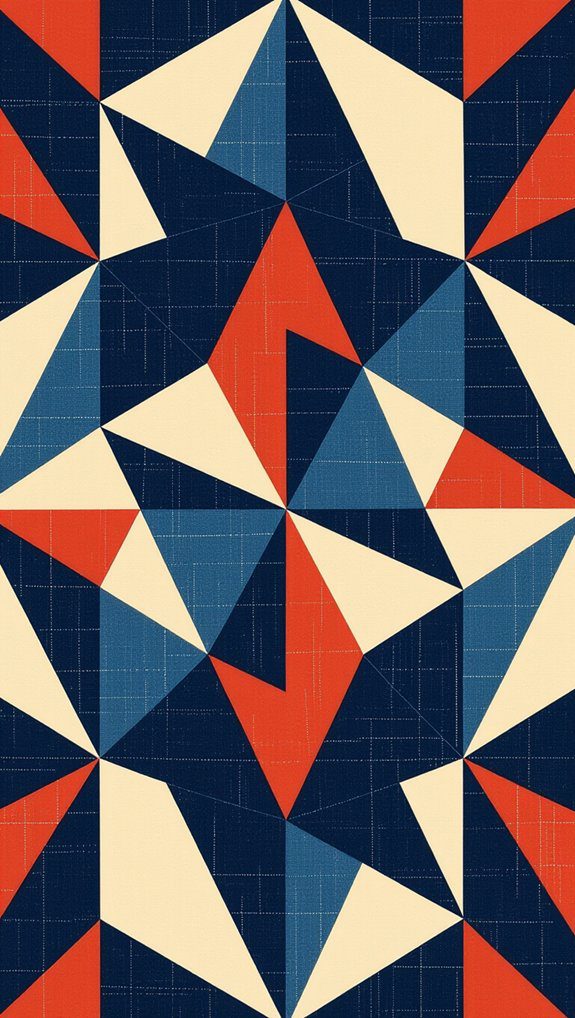
If you’ve admired the deep, flowing patterns of traditional indigo batik, you’re in for a fresh experience with modern geometric batik patterns. These designs use sharp lines and bold shapes, blending geometric symbolism with contemporary influences to express unity, balance, and harmony. I love how vibrant colors and repetitive shapes create a striking, fresh look that feels both timeless and trendy. Whether crafted with Batik Tulis, Batik Cap, or digital printing, these patterns connect us to culture while appealing to today’s tastes. Embracing this style means joining a creative community that values both tradition and innovation.
Floral Batik Motif
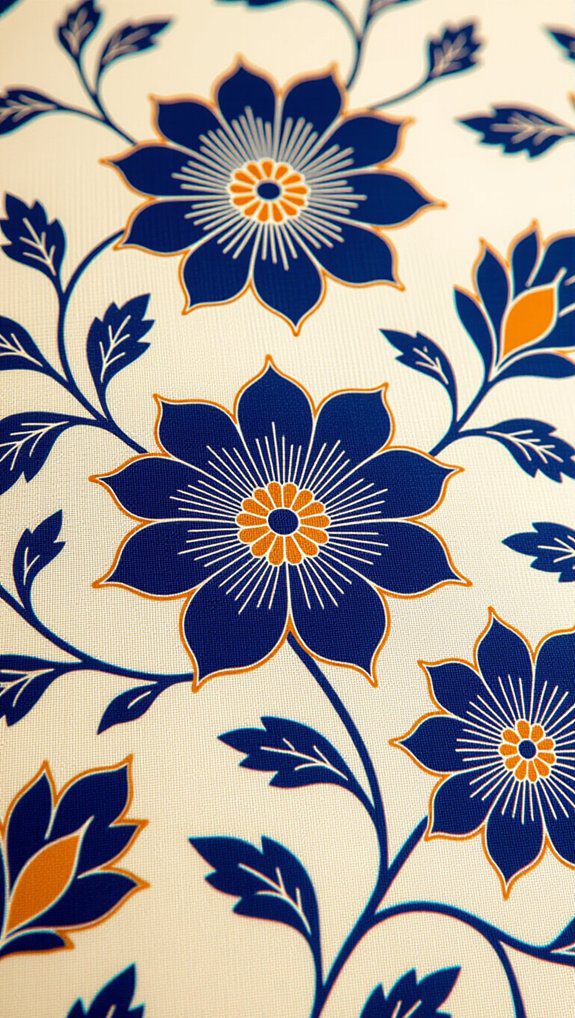
What makes floral batik motifs so enchanting is how they beautifully blend art and meaning in every petal and leaf. When I create floral batik, I focus on flower symbolism—like the lotus for purity or jasmine for love—which adds depth to each design. Using batik techniques like Batik Tulis and Batik Cap, I carefully craft these patterns, blending tradition with creativity. The vibrant, natural dyes bring life to the fabric, making each piece feel warm and inviting. Floral motifs aren’t just pretty; they connect us, symbolizing growth and unity, especially in special celebrations like weddings.
Abstract Wax Resist Batik

Abstract wax resist batik opens up a whole new world of creativity by mixing tradition with modern flair. I love how this technique invites design experimentation, letting me play freely with shapes and patterns. Using color theory, I choose vibrant dyes that contrast beautifully with the waxed areas, creating stunning abstract effects. First, I sketch my design, apply wax with a canting tool, then dye the fabric. After boiling off the wax, the final pattern reveals a distinctive combination of texture and color. This process connects me to a creative community, sharing a passion for bold, expressive textile art.
Tie-Dye Batik Technique
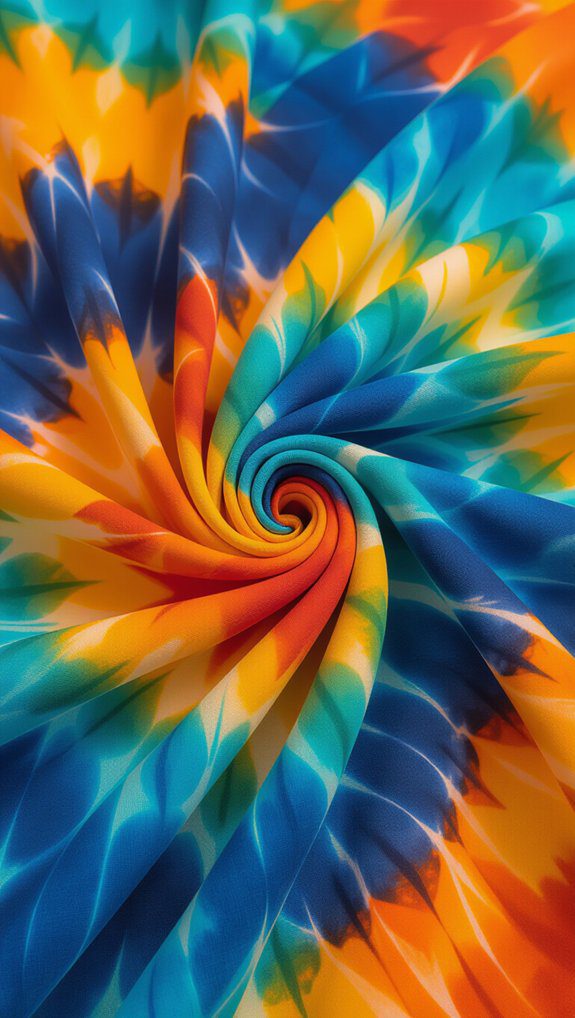
While tie-dye and batik might seem like very different techniques, combining them creates a fascinating way to make colorful, eye-catching patterns. In tie-dye batik, you fold and bind fabric to create spiral designs using resist techniques that keep dye from coloring certain areas. This mix lets you explore vibrant colors while honoring traditional batik’s cultural roots. I love using natural dyes for a sustainable touch, and the process invites creative play, perfect for workshops or solo projects. Plus, trying different fabrics adds texture and fun variations. Give it a go—you’ll feel part of a wonderful artistic community!
Batik Border Pattern Design
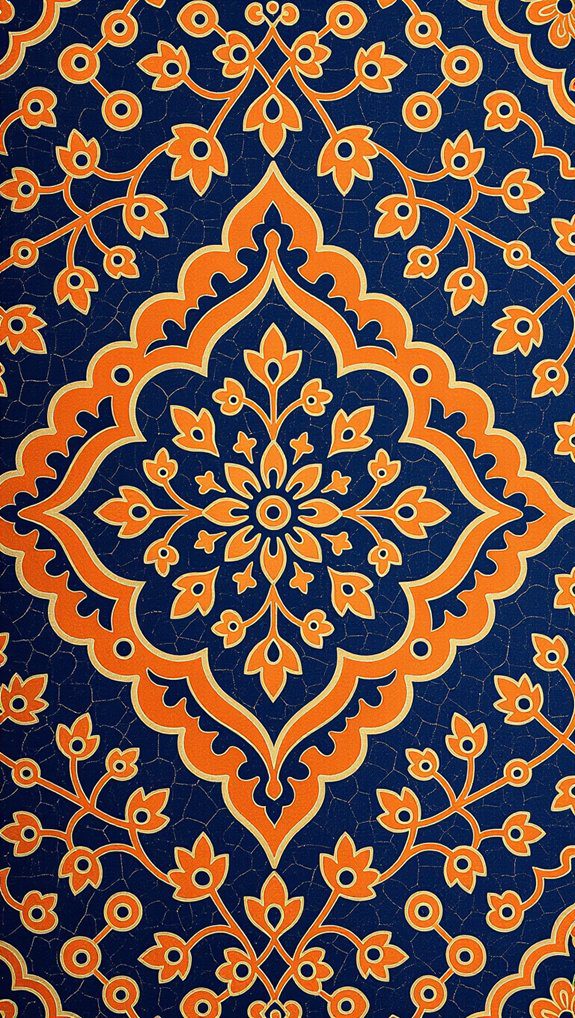
Borders in batik designs play a special role that goes beyond just framing the fabric—they tell stories and add meaning to the whole piece. Comprehending border significance helps us appreciate the cultural symbolism woven into each pattern. Here’s what I’ve learned:
- Borders use repeating motifs that often symbolize prosperity or protection.
- Floral and geometric shapes reflect Javanese artistry and nature’s influence.
- Colors carry meaning—red for bravery, green for spirituality.
- Regional styles, like those from Pekalongan or Solo, showcase diverse cultural roots.
When designing, remember: borders unite beauty with deep stories, inviting us to belong.
Crackle Effect Batik
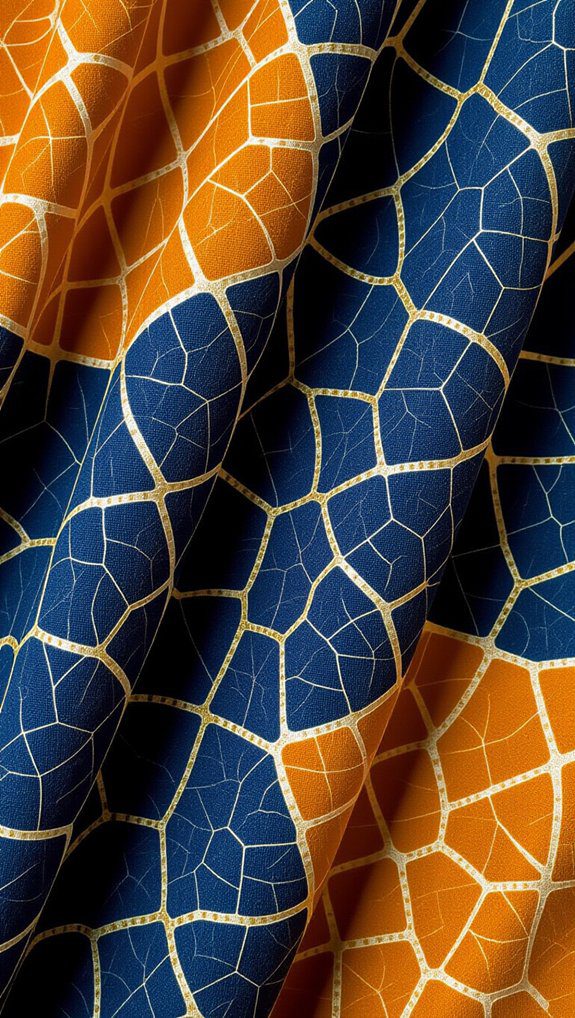
One fascinating feature of batik that always catches my eye is the crackle effect, which adds a wonderful texture and depth to the fabric. This crackle texture comes from a special wax application that hardens and contracts, creating tiny cracks when dyed. Controlling wax temperature is key—too hot, and the pattern melts away. I love how this technique blends beautifully with other batik styles, letting artists tell stories through colors and motifs. If you’re keen to try, focus on careful waxing and watch the magic unfold as the dye seeps into those delicate cracks.
Tribal Batik Print
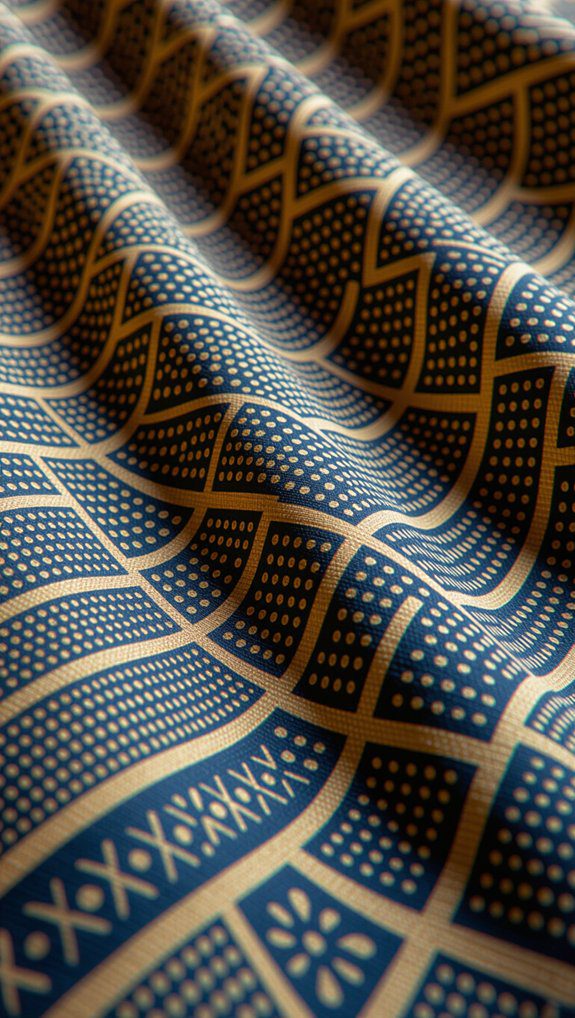
Tribal Batik prints captivate me with their bold geometric designs and vibrant colors, each pattern telling a unique story rooted in indigenous cultures. These prints thrive on tribal symbolism and cultural storytelling, making every piece feel alive with meaning. When you explore tribal Batik, consider these essentials:
- Motifs inspired by nature and ancestral beliefs.
- Use of natural dyes that honor the environment.
- Bold shapes that represent community identity.
- Patterns that preserve cultural heritage while embracing modern style.
Ocean Wave Batik Pattern
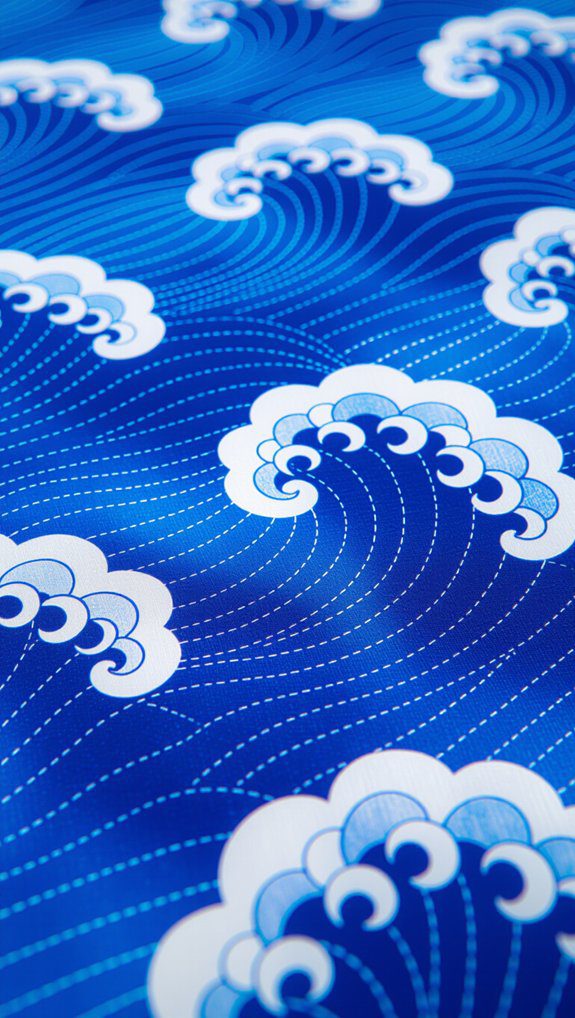
Whenever I immerse myself in the world of Ocean Wave Batik patterns, I’m instantly drawn to the graceful flow of lines and curves that mimic the gentle movement of water. This design’s ocean symbolism expresses calmness and nature’s rhythm, making it feel deeply peaceful. Using dyeing techniques like Batik Tulis and Batik Cap, artisans layer blues and greens, creating rich, textured waves that truly come alive. It’s amazing how these patterns connect us, reminding us of the ocean’s beauty and serenity. If you want a batik piece that feels both natural and meaningful, this pattern is a perfect choice.
Mandala Batik Design
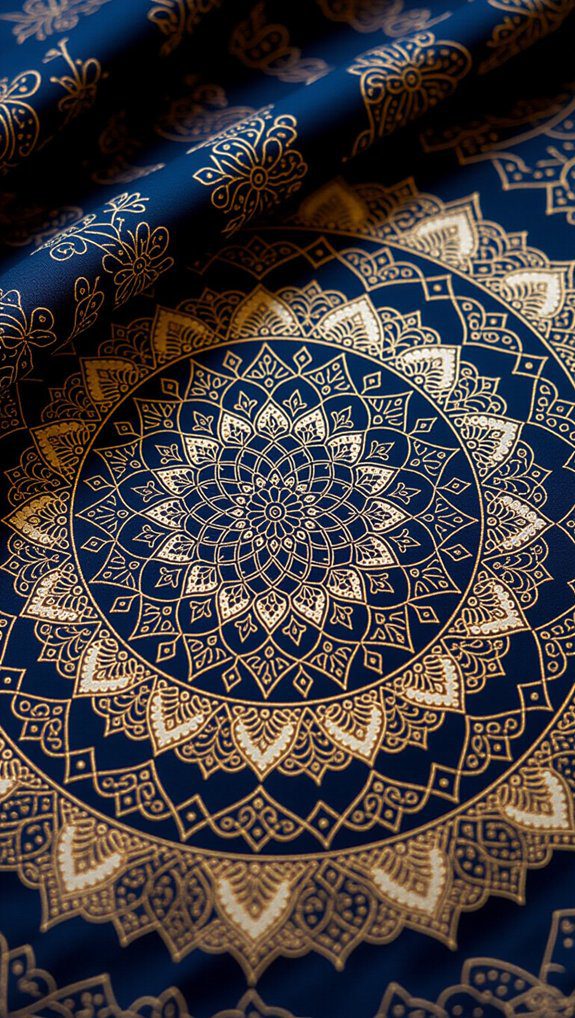
Mandala batik designs captivate me with their intricate circular patterns that seem to draw you into a world of harmony and connection. These patterns carry deep cultural significance and harmony symbolism, created using traditional techniques like Batik Tulis or Batik Cap. The vibrant colors—reds, blues, yellows—bring these meditative patterns to life, inviting artistic mindfulness. I love exploring contemporary interpretations that blend old and new styles. Here’s why mandala batik feels so special:
- Intricate detailing showcases skilled craftsmanship
- Meditative patterns encourage reflection
- Vibrant colors express emotion
- Cultural significance connects us to tradition
Together, they create a beautiful, mindful art form.
Animal Print Batik

Animal print batik designs bring a lively and enchanting energy to the art form, blending nature’s beauty with rich cultural stories. When I work with animal motif symbolism, I’m reminded how creatures like peacocks or elephants represent community and strength. Using traditional batik craftsmanship techniques like Batik Tulis or Batik Cap, artisans create detailed, meaningful designs that connect us to cultural roots. These prints aren’t just pretty patterns—they tell stories of interdependence and belonging. If you want your textile art to feel alive and deeply connected, animal print batik offers a perfect mix of heritage and creative expression.
Circular Batik Motif
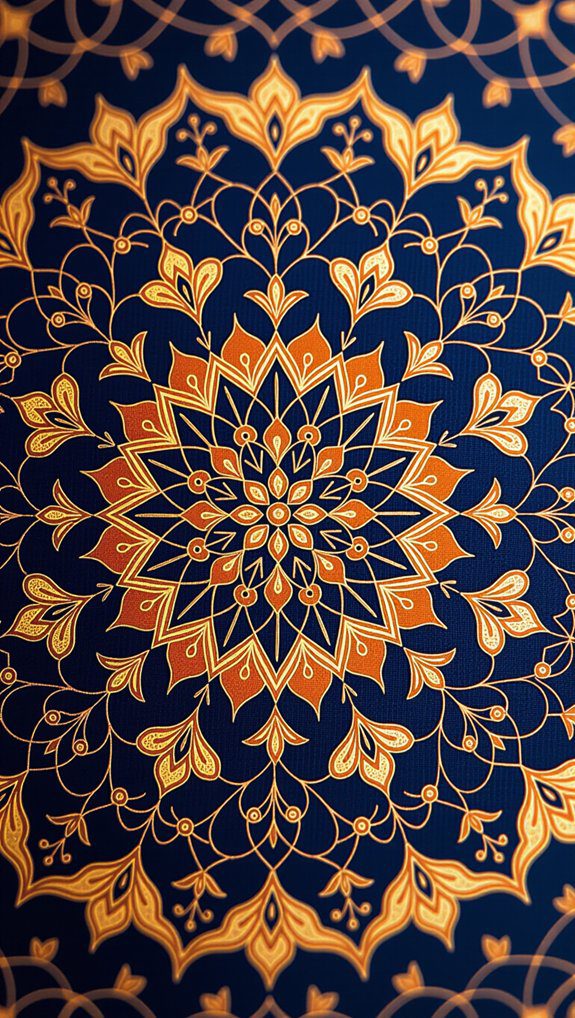
Circles have a special way of capturing attention, and in batik, circular motifs carry deep meanings that I find truly fascinating. These designs celebrate circular symbolism and cyclical themes, connecting us to nature’s rhythms. Here’s why I love them:
- They symbolize unity and wholeness, reflecting life’s interconnectedness.
- Circular motifs often represent natural elements like the sun or flowers.
- They express cyclical themes such as seasons and life cycles.
- Creating these patterns showcases skilled artistry, whether handwritten or stamped.
Embracing circular batik motifs helps us feel part of a timeless, shared story.
Striped Batik Pattern
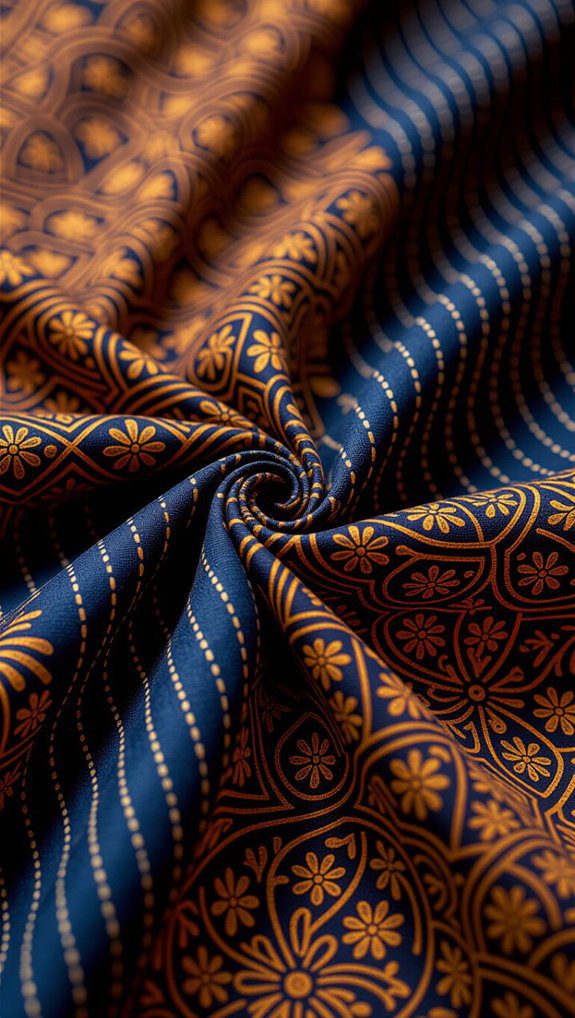
Stripes bring a lively rhythm to batik designs, and I’ve always admired how they add both movement and meaning to the fabric. Striped batik patterns showcase rhythmic flow, blending cultural symbolism with harmonious balance. Whether hand-drawn or stamped, these stripes tell stories of nature and tradition. Here’s how stripes can connect us:
| Emotion | Meaning |
|---|---|
| Unity | Cultural Symbolism |
| Energy | Rhythmic Flow |
| Balance | Natural Harmony |
Leaf and Vine Batik Design

When you look closely at Leaf and Vine Batik designs, you’ll notice how the delicate patterns of leaves and twisting vines create a sense of growth and harmony that feels almost alive. This design celebrates nature symbolism through artisan techniques like Batik Tulis, where every detail reflects skilled hands. Here’s why I love it:
- It connects us with nature’s beauty and cycles.
- The green and earth tones calm and inspire.
- Each pattern tells a story of environmental respect.
- It’s a traditional art from Yogyakarta and Solo, rich in culture.
Join me in appreciating this living art form!
Color Block Batik Art
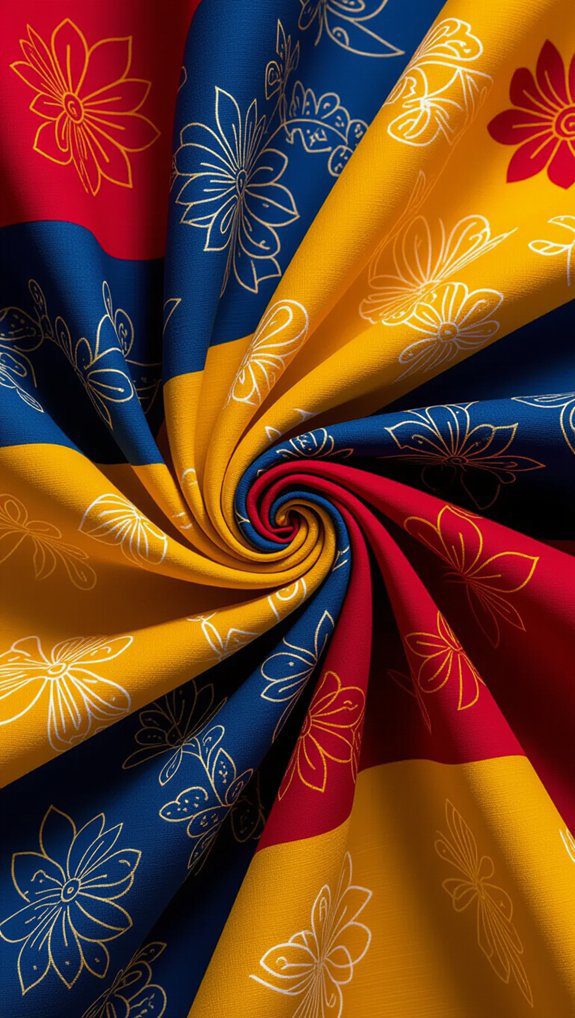
Color block batik art offers a striking way to bring bold shapes and vibrant colors to life on fabric, and I’m excited to share how this style changes traditional batik into something fresh and modern. By using design techniques like applying wax to create clean lines, we can separate vivid color blocks that carry deep color meanings—red for bravery, green for religiosity, and more. Whether you choose Batik Tulis or Batik Cap methods, this approach blends tradition with contemporary flair. It’s a wonderful way for us to connect through art that feels both personal and culturally rich.
Symmetrical Batik Pattern
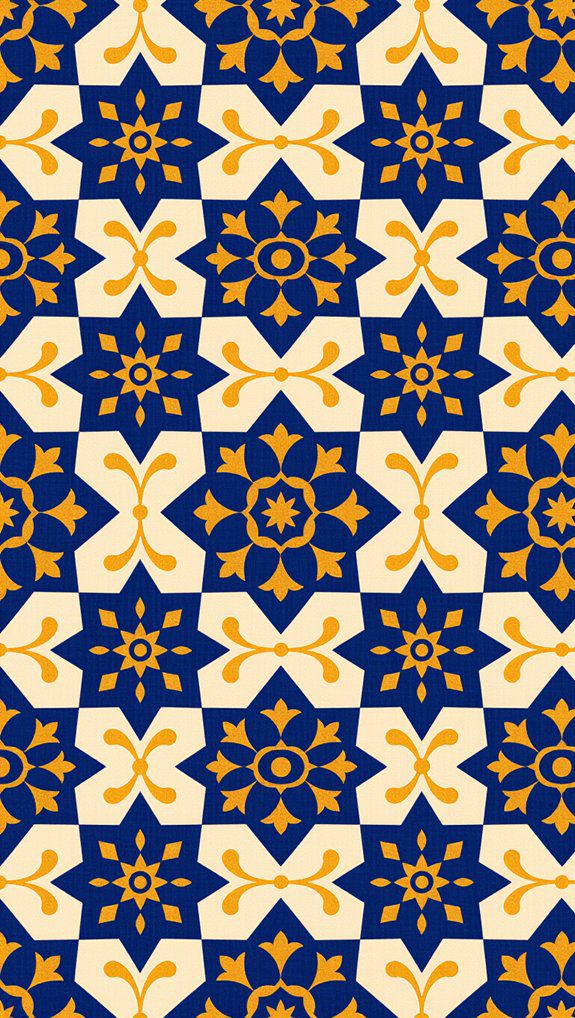
A symmetrical batik pattern draws you in with its balanced and mirrored designs that echo the harmony found in nature and Javanese philosophy. These patterns carry deep cultural significance, using symmetry concepts to express unity and balance. When creating them, I focus on design techniques like Batik Tulis or Batik Cap for precision. Here’s what makes symmetrical patterns special:
- Motif symbolism often includes flowers and geometric shapes.
- They reflect Javanese philosophy about life’s duality.
- Patterns like Truntum symbolize love and renewal.
- Artistic expression shines through careful planning.
Embracing these elements brings us closer to tradition and community.



